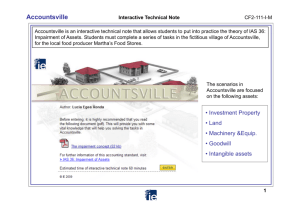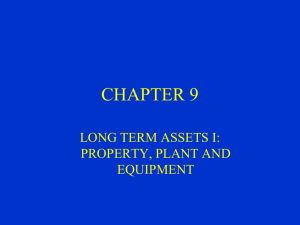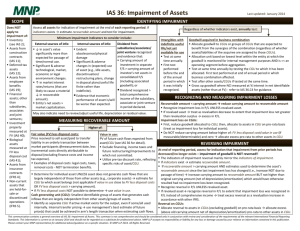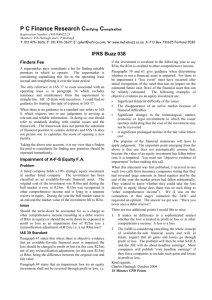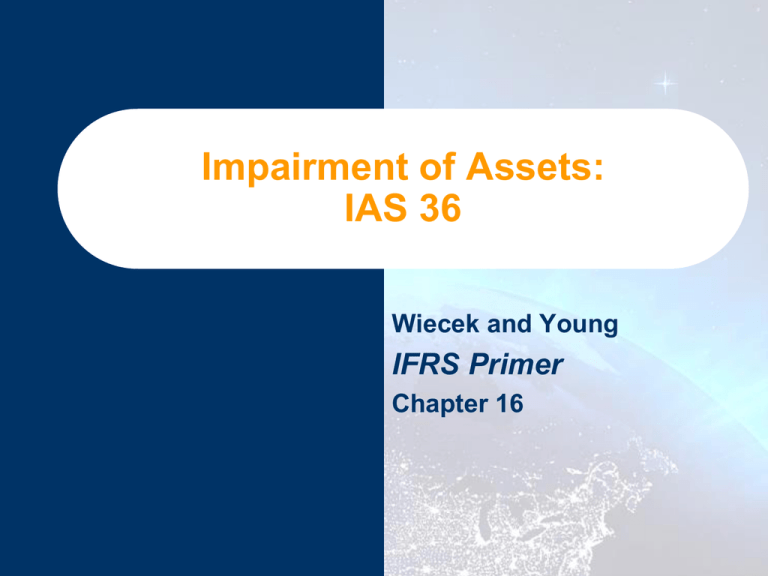
Impairment of Assets:
IAS 36
Wiecek and Young
IFRS Primer
Chapter 16
Impairment of Assets
2
Related standards
IAS 36
Current GAAP comparisons
IFRS financial statement disclosures
Looking ahead
End-of-chapter practice
Related Standards
3
FAS 157 Fair value measurements
FAS 144 Accounting for the impairment or
disposal of long-lived assets
FAS 142 Goodwill and other intangible
assets
FAS 141 Business combinations
Related Standards
4
IFRS 3 Business combinations
IAS 16 Property, plant and equipment
IAS 17 Leases
IAS 27 Consolidated and separate financial
statements
IAS 28 Investments in associates
IAS 31 Interests in joint ventures
IAS 38 Intangible assets
IAS 40 Investment property
IAS 36 – Overview
5
Objective and scope
Identifying an asset that might be impaired
Recognizing and measuring an impairment
loss for an individual asset
Recognizing and measuring an impairment
loss for cash-generating units and goodwill
Reversing an impairment loss
Disclosure
IAS 36 – Objective and Scope
6
IAS 36 ensures that assets are reported on
the statement of financial position at no more
than the entity can recover from their use or
sale.
May be an impairment loss—“the amount by
which the carrying amount of an asset or a
cash-generating unit (CGU) exceeds its
recoverable amount”
IAS 36 – Objective and Scope
IAS 36 excludes:
–
–
–
–
–
–
–
7
inventories
assets arising from construction contracts
employee benefit assets
deferred tax assets
financial assets under IAS 39
non-current assets or disposal groups held-forsale
investment property, biological assets based on
FV measurements
IAS 36 – Objective and Scope
8
IAS 36 – Identifying an Asset that
May Be Impaired
Assets
–
–
–
Intangibles with indefinite lives, those not yet
ready for use, and goodwill
–
–
9
end of each reporting period
assess for indications of impairment
if indications of impairment, test for impairment
annually
test for impairment regardless of indications of
impairment
IAS 36 – Identifying an Asset that
May Be Impaired
Indication of impairment? Consider:
10
IAS 36 – Identifying an Asset that
May Be Impaired
Testing for impairment:
Estimate asset/CGU’s recoverable amount. If
recoverable amount is greater than the
carrying amount – no impairment.
Recoverable amount - higher of:
–
–
11
fair value less costs to sell, and
value in use
IAS 36 – Identifying an Asset that
May Be Impaired
12
For assets that do not generate independent
cash flows on their own – group into cashgenerating units (CGUs)
CGU – “the smallest identifiable group of
assets that generates cash flows that are
largely independent of the cash flows from
other assets or groups of assets”
IAS 36 – Identifying an Asset that
May Be Impaired
13
Fair value less costs to sell = proceeds from arm’slength sale of an asset/CGU between
knowledgeable willing parties less incremental direct
costs of its disposal
Best measure: arm’s-length bargained price in a
binding sales agreement in an active market.
Hierarchy of appropriate methods to establish fair
value
Disposal costs: e.g., legal costs, transaction taxes,
removal costs, costs to put in condition for sale
IAS 36 – Identifying an Asset that
May Be Impaired
Value in use = present value of the future
cash flows expected from asset/CGU’s use
and ultimate disposal
Two approaches:
1.
2.
14
Most likely cash flows from use and disposal
discounted using risk-adjusted discount rate.
Probability-weighted cash flows from use and
disposal discounted using remaining riskadjusted discount rate.
IAS 36 – Identifying an
Asset that May Be Impaired
15
Estimated cash flows with a 40% probability they will
be $120 and a 60% probability they will be $80.
Value in use?
Method 1: Most likely cash flows = $80. This amount
is discounted using a rate that takes into account all
risks including the uncertainty of the cash flow
amounts.
Method 2: Expected value of cash flows = (120 ×
40%) + (80 × 60%) = $96. This amount is discounted
using a rate that includes remaining risks.
IAS 36 – Recognizing and Measuring an
Impairment Loss for an Individual Asset
If recoverable amount < carrying amount:
Dr. Impairment loss
$
Cr. Accumulated impairment losses
16
$
Recalculate depreciation rate.
If recoverable amount > carrying amount: no
impairment
IAS 36 – Recognizing and Measuring an
Impairment Loss for CGUs and Goodwill
CGU’s carrying amount
= carrying amount of all assets used to
generate the relevant stream of cash flows
Includes assets
–
–
17
directly involved, and
those allocated to the CGU on a reasonable basis
IAS 36 – Recognizing and Measuring an
Impairment Loss for CGUs and Goodwill
Goodwill allocated to a CGU or group of
CGUs not larger than an “operating segment”
that is:
–
–
–
18
expected to benefit from synergies of a
combination
at lowest level in organization that manages the
goodwill
not on an arbitrary basis
IAS 36 – Recognizing and Measuring an
Impairment Loss for CGUs and Goodwill
If part of CGU with allocated goodwill is sold:
–
–
19
allocate goodwill between portion sold and portion
remaining
base on relative value of the CGU sold to portion
retained
IAS 36 – Recognizing and Measuring an
Impairment Loss for CGUs and Goodwill
Testing CGUs for impairment
CGUs with related G/W not allocated
specifically:
–
–
CGUs with G/W allocated to it
–
–
20
Test when an indication of impairment
Loss = CGU carrying amount excluding G/W recoverable amount
Test at least annually
Loss = CGU carrying amount including G/W –
recoverable amount
IAS 36 – Recognizing and Measuring an
Impairment Loss for CGUs and Goodwill
Impairment loss for a CGU or group of
CGUs:
–
–
21
assign loss to carrying amount of G/W allocated
to the CGU or group
allocate remainder to assets in CGU on basis of
relative carrying amounts
Loss is impairment loss for individual assets
in CGU
IAS 36 – Reversing an Impairment Loss
22
No reversal of impairment loss for G/W
For other assets, reversal permitted if
estimates used to determine recoverable
amount have changed
IAS 36 – Reversing an Impairment Loss
For an individual asset:
–
–
23
reversal limited to an increase to what asset
would have been, net of
depreciation/amortization, if no impairment had
been recognized initially
unless accounted for under the revaluation model
– when full reversal is permitted
IAS 36 – Reversing an Impairment Loss
For a CGU:
–
–
–
24
reversal is allocated to the assets of the unit,
excluding G/W
on basis of relative carrying amounts
restrictions on individual assets still apply
IAS36 – Disclosure
For each class of assets:
–
–
–
25
amount of impairment loss/loss reversals in P&L
line item where loss/reversal is reported
amount of impairment loss/loss reversals on
revalued assets in OCI
IAS36 – Disclosure
Individually material loss/reversal:
–
–
–
–
26
explanation of events and circumstances
nature of asset/CGU
how recoverable amount is determined
amount of loss/reversal
IAS36 – Disclosure
For G/W and intangibles with indefinite lives:
–
–
–
–
27
considerably more information provided
enable users to assess reliability of impairment
testing
for individually significant intangible assets/CGUs
if individually insignificant, disclose amounts
Current GAAP Comparisons
28
–
Pages 19 to 20 of 49 of
http://www.ey.com/Global/assets.nsf/International/
IFRS_US_GAAP_vs_IFRS/$file/US_GAAP_vs_IF
RS.pdf
–
Pages 82 to 84 of 164 of
http://www.kpmg.co.uk/pubs/IFRScomparedtoU.S
.GAAPAnOverview(2008).pdf
IFRS Financial Statement Disclosures
Cadbury Schweppes plc
–
Impairment policy note for goodwill and
acquisition intangibles
–
Page 93 of 153
Goodwill Note 14
–
29
http://www.cadbury.com/Reports/2007AnnualRep
ort.pdf
Page 104 of 153
Looking Ahead
IAS 36
–
–
–
–
Impairment
–
–
30
two recent revisions
resulting from project on business combinations
changes to IAS 27 and IFRS 3 – released in 2008
related to impairment test for goodwill
part of longer term convergence
no short or medium term changes likely
End-of-Chapter Practice
31
16-1 Three years ago, Ace Airlines (AA) was granted
permission to schedule flights on the popular and profitable
Newalta to Oldsford route, provided it also serviced Remoteville
which is considerably further north than Oldsford. As a result,
AA set up a facility in Oldsford and a small office and
maintenance bay in Remoteville. Remoteville is sparsely
populated and not accessible except by air. AA’s controller now
wants to review the Remoteville assets for impairment due to
the continuing losses on the Oldsford-Remoteville route, but is
not familiar with IAS 36.
Instructions
Write a short memo to AA’s controller, identifying how he
should proceed in determining whether the Remoteville assets
are impaired.
End-of-Chapter Practice
16-2 Waix Ltd. (WL) is a manufacturer with a number of product lines, one
of which is the production of parts for residential telephone sets. Recently
there have been indications that the market for this product is likely to
decline significantly, and WL is assessing various assets for impairment.
The following assets are used specifically to manufacture these parts:
Tools and dies
Specialized equipment
General equipment
Cost
____
$ 10
50
30
Accumulated
Depreciation
$ 6
35
18
The tools and dies and specialized equipment have no resale value other
than for scrap, although the general equipment could be sold or used
profitably in one of WL’s other product lines. WL plans on continuing
production of these parts for two more years in order to fill its existing
commitments. The present value of the net cash flows from the next two
years’ production of these parts is $26 and the estimated net amount that
could be recovered if these assets were sold today is $15.
32
End-of-Chapter Practice
16-2 Instructions
a)
b)
c)
33
Briefly discuss whether these assets should be assessed for
impairment individually or as part of a cash-generating unit.
Assuming the assets are allocated to a CGU made up of the
three types of assets identified, determine whether an
impairment loss needs to be recognized, and if so, in what
total amount.
Prepare the entry needed to record any impairment loss
indicated, assuming these assets are reported in separate
asset classes.
End-of-Chapter Practice
16-3 Firstall Corp. (FC) acquired four divisions of a competitor eight years
ago in a business combination transaction, paying $25 more than the fair
value of the identifiable assets acquired. The goodwill was determined to
be 100% attributable to the operations of the East Division and the South
Division. Although these two divisions are cash-generating units in their
own right, there was no basis on which to allocate the goodwill between
them. FC has identified the combined divisions as one CGU for assessing
goodwill impairment on an annual basis. At the end of the most recent
year, the following information is available:
Carrying Amount
East Division
$ 75
South Division
125
Goodwill
25
FC has determined that the estimated recoverable value of the two
divisions together is $215.
34
End-of-Chapter Practice
16-3 Instructions
a)
b)
c)
35
Identify the asset, cash-generating unit, or group
of CGUs that FC should use to test for
impairment.
Is there an impairment loss at the end of the
current year? Explain how you determined your
answer.
If applicable, indicate how any impairment loss
should be accounted for. Be specific.
End-of-Chapter Practice
16-4 In this chapter, flag icons identify areas where there are
GAAP differences between IFRS requirements and national
standards.
Instructions
Access the website(s) identified on the inside back cover of this
book, and prepare a concise summary of what the differences
are that are flagged throughout the chapter material.
36
Copyright © 2010 John Wiley & Sons, Inc. All rights reserved.
Reproduction or translation of this work beyond that permitted
by Access Copyright is unlawful. Requests for further
information should be addressed to the Permissions
Department, John Wiley & Sons Inc., 111 River Street, Hoboken,
NJ 07030-5774, (201) 748-6011, fax (201) 748-6008, website
http://www.wiley.com/go/permissions. The purchaser may make
back-up copies for his or her own use only and not for
distribution or resale. The author and the publisher assume no
responsibility for errors, omissions, or damages caused by the
use of these programs or from the use of the information
contained herein.

